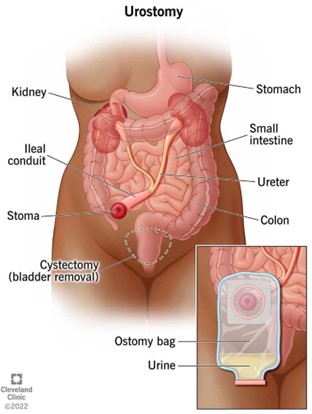A nurse is caring for a client who has an ileostomy.
Nurses' Notes
Day 1:
- Client is alert and oriented.
- ileostomy stoma is pink.
- Stoma draining moderate brown liquid stool.
- Client will not look at the stoma.
- Client states they are not interested in learning about stoma care.
- Intake: 2,200 mL over the last 24 hr
- Urine output: 1,200 ml over the last 24 hr
Day 2:
- ileostomy pouch changed. Skin surrounding the stoma is reddened and appears irritated
- initiated a request for a referral to an ostomy nurse.
- intake. 1,600 mL over the last 24 hr
- Urine output: 650 mL over the last 24 hr
The nurse is reviewing the client's medical record. Select the information that requires intervention by the nurse.
Ileostomy stoma is pink.
Stoma draining moderate brown liquid stool.
Client will not look at the stoma.
Client states they are not interested in learning about stoma care
Intake: 2,200 mL over the last 24 hr
Skin surrounding the stoma is reddened and appears iritated
Urine output: 650 mL over the last 24 hr
Correct Answer : F
f) Skin surrounding the stoma is reddened and appears irritated.
The information that requires intervention by the nurse is that the skin surrounding the stoma is reddened and appears irritated. This may indicate that the client is experiencing skin irritation or breakdown, which can lead to infection or other complications. The nurse should assess the skin and initiate appropriate interventions to prevent further skin damage.
Options a, b, c, d, e, and g do not necessarily require intervention by the nurse. A pink ileostomy stoma and moderate brown liquid stool drainage are normal findings. The client's refusal to look at the stoma or learn about stoma care may be concerning, but it is not an immediate priority for intervention. An intake of 2,200 mL over 24 hours and a urine output of 650 mL over 24 hours are within normal limits.

Nursing Test Bank
Naxlex Comprehensive Predictor Exams
Related Questions
Correct Answer is B
Explanation
The client's belief that their needs will be met through education is the most likely factor to increase their motivation to learn how to self-administer daily low-dose heparin injections. When a client believes that they will benefit from the education and that it will help them meet their needs, they are more likely to be motivated to learn.

a. The nurse's empathy about the client having to self-inject may help build rapport with the client, but it is not the most important factor in increasing the client's motivation to learn.
c) The client seeking family approval by agreeing to a teaching plan may be a motivating factor for some clients, but it is not the most important factor in increasing the client's motivation to learn.
d) The nurse explaining the need for education to the client may help increase the client's understanding of the importance of learning how to self-administer heparin injections, but it is not the most important factor in increasing the client's motivation to learn.
Correct Answer is C
Explanation
The nurse should assist the client with a bowel cleansing before an intravenous pyelogram. This helps to ensure that the bowel is empty and that the images obtained during the procedure are clear. The other
a. Oral contrast is not typically used for an intravenous pyelogram.
b. Pain in the suprapubic region is not a common side effect of an intravenous pyelogram.
d. Removing metal objects is important for procedures that use magnetic resonance imaging (MRI), but it is not necessary for an intravenous pyelogram.

Whether you are a student looking to ace your exams or a practicing nurse seeking to enhance your expertise , our nursing education contents will empower you with the confidence and competence to make a difference in the lives of patients and become a respected leader in the healthcare field.
Visit Naxlex, invest in your future and unlock endless possibilities with our unparalleled nursing education contents today
Report Wrong Answer on the Current Question
Do you disagree with the answer? If yes, what is your expected answer? Explain.
Kindly be descriptive with the issue you are facing.
